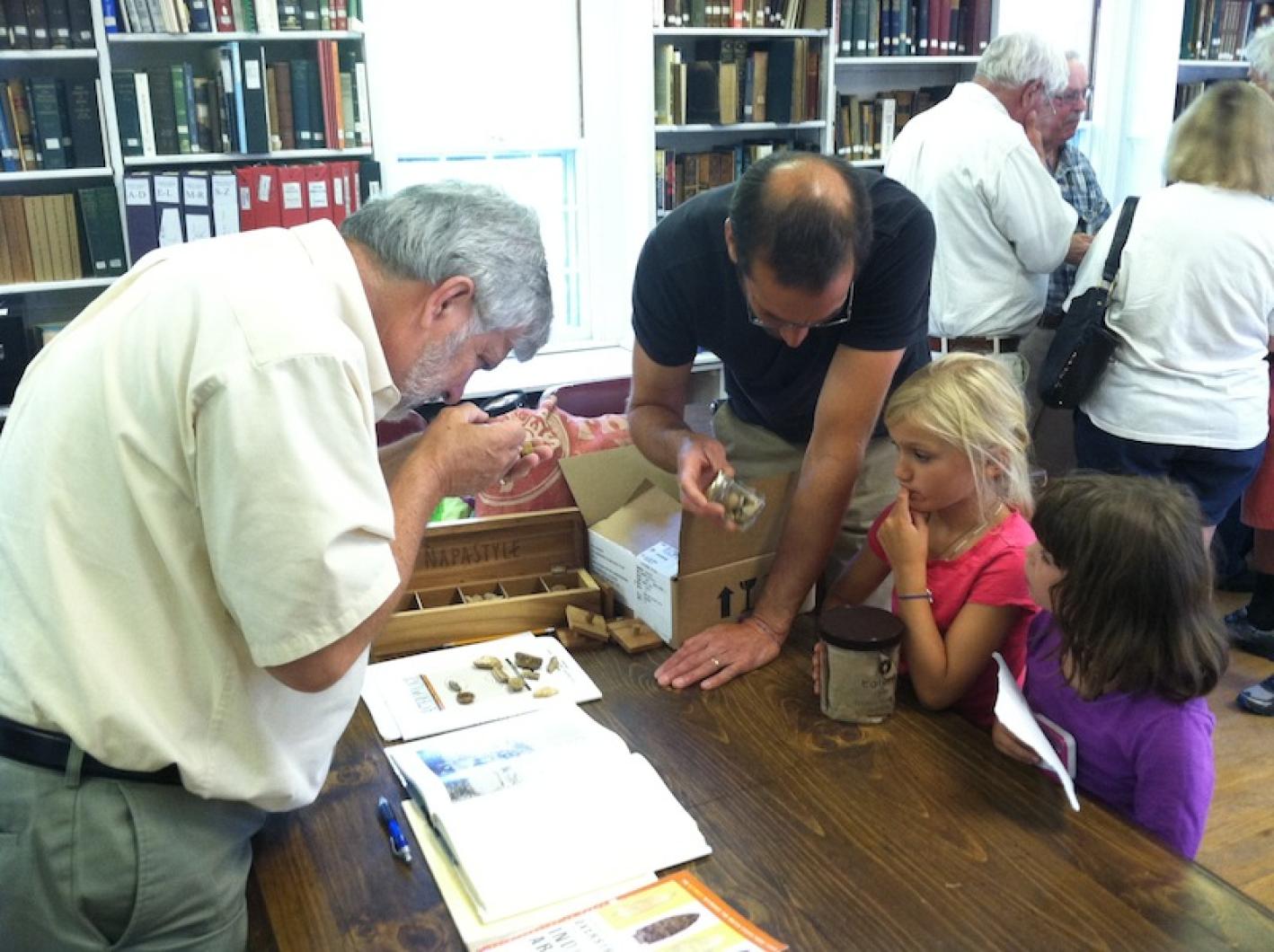Even before rising sea levels created the Islands of Martha’s Vineyard and Nantucket about 6,000 years ago, Native Americans in the northeast were at work fashioning arrowheads, knives, and other stone implements for daily use.
Stories of the distant past came to life during archaeology ID day at the Martha’s Vineyard Museum on Saturday. The infrequent event drew a steady stream of visitors who brought whale bones, arrowheads and other treasures from around the Island to the museum library, where the objects were identified by archaeologists and a marine paleobiologist.
Most of the artifacts that people find on the Island are relatively common, said museum board member James Richardson, who is also curator emeritus at the Carnegie Museum of Natural History.
“A few things go back to 10,500 years ago, but in the main it’s 9,000 years and later that you really find more dense occupation on the Vineyard, so there’s more archaeological materials,” he said.
While working in his garden, Doug Goldsmith of Chilmark discovered a white quartz arrowhead that the panelists on Saturday dated to about 8,000 BCE. He said the stone itself had fractures and would have been especially difficult to shape.
“People have been saying how much they admire the persistence and the ingenuity of the person making it, knowing how to work difficult materials,” Mr. Goldsmith said, adding that he was eager to find others artifacts.
Patricia Correia came to the museum with the central portion of a large whale vertebra that had been rolled smooth by the surf. It was discovered in the 1930s by her father-in-law, John Correia, who managed Eldridge’s Fish Market in Edgartown. “I’ve just had it around,” Mrs. Correia said. “For a long time I just thought it was a peculiar stone, but I knew it wasn’t like other stones.”
Duncan Caldwell, a well-known archaeologist who does much of his research in France but also lives on the Vineyard, said the whale had probably died within the last 150 years.
“A lot of whale material comes up on the Vineyard,” he said, noting that the bones of a whale that washed up on Lucy Vincent Beach in the early 1990s are still being found. He advised Mrs. Correia to keep the whale bone indoors where it would be safe from acid rain.
Midway through the morning, archaeologist Bill Moody, along with Mr. Caldwell, offered a demonstration of ancient lithophones – stone instruments that until recently had been identified as pestles. The long cylindrical stones are flat on one side and can be rested horizontally. When struck they create tones similar to a muted bell.
“Before these were studied nobody had tried playing them,” Mr. Moody said. He believes they may have been invented during the process of chipping away at stones to create tools.
One of the lithophones was discovered at Amoskeag Falls in southern New Hampshire and the other in the Connecticut River Valley in central Massachusetts. Others have been found throughout the world.
This was the first time lithophone sounds were heard on Martha’s Vineyard in more than 5,000 years or so, said Mr. Caldwell, who identified Mr. Moody’s two lithophones (the first to be identified in the United States) and whose paper last year in the journal American Antiquity describes them in detail.
The five or six local experts were busy all morning identifying a broad range of bones, fossils, rocks and artifacts. Visitors conversed with each other and shared their stories.
Thomas Bena, along with his young daughter Emma and her friend Lydia Bach, arrived with a cardboard box full of ancient shark teeth, fossilized bone fragments, vertebrae and other objects they had collected at Lucy Vincent Beach in Chilmark. They watched eagerly as Frederick Hotchkiss, director of the Marine Paleobiological Research Institute in Vineyard Haven, examined each one through a magnifying glass.
“These were from when dinosaurs were walking on the earth,” Mr. Hotchkiss said, handling a small bone fragment that was dark brown and worn smooth. He said some of the shark teeth may have been smaller specimens from the giant megalodon, which prowled the oceans between 2 and 20 million years ago.
“This just blows my mind,” said Mr. Bena, as each object told its story.
The monetary value of fossils is largely subjective, said Mr. Hotchkiss, who organizes events for National Fossil Day in Oak Bluffs in October. In general, he said, collectors are more interested in fossils themselves than in making a profit.
Finding a fossil is often a matter of knowing what to look for, he said. “Of the thousands of people who come here, most really don’t find or see anything. But the people who have the trained eye, it’s amazing what they find.”
But he added that skill can only go so far. “You have to be lucky,” he said.






Comments (1)
Comments
Comment policy »